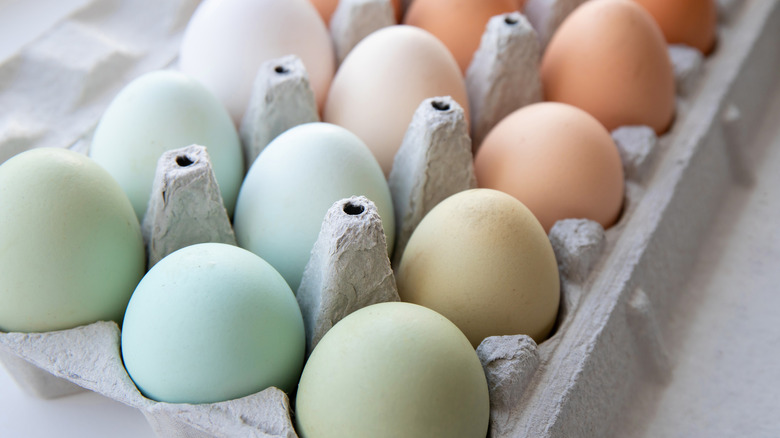Why You Never See Different Colored Eggs At The Grocery Store
Wander through the egg aisle at any supermarket in the United States and you'll mostly see one color: white. Maybe a few brown-shelled options appear, but that's it. Chickens can lay eggs ranging from pale blue to olive green to chocolate-brown, so why do grocery stores almost exclusively stock boring old white eggs? The answer lies in industrial farming, consumer expectations, and a streamlined supply system.
Most mass-market producers in the U.S. rely on a specific breed of chicken known as the white leghorn. These productive little hens lay white-shelled eggs almost daily and are quite fertile, making them the preferred chicken for large-scale egg operations. These birds are also relatively small and can handle both cold and heat. Factory farming is nothing if not efficient animal husbandry at a massive scale, and that's just what these hens do.
If you're wondering where the brown eggs come from, they're typically laid by larger, heavier breeds like Rhode Island reds or Plymouth Rocks, which eat more and produce fewer eggs than leghorns. In fact, that's why brown eggs often cost more. It's not because they're healthier and tastier than white eggs, but because they're more expensive to produce. And if you want blue, green, or speckled eggs, you're going to have to hunt for harder-to-find breeds that aren't always reliable with their egg duties because they're too busy being fabulous. In a system that prizes predictability and sameness, these fancy chickens are a no-go.
Colored eggs are not as efficient to produce
There's also the matter of freshness and shelf life for small-farm eggs. Pretty heritage-breed eggs are typically produced on small farms and sold locally. Grocers work with enormous volume and national suppliers, making it difficult for smaller, niche producers to enter the mainstream supply chain. Of course, this is changing slowly with the rise of farmers' markets and Community Supported Agriculture (CSA) boxes, where Easter egg-colored mixes from curated backyard breeds have become social media fodder. For now, such eggs remain a novelty.
Ultimately, the scarcity of beautiful, pastel eggs in grocery stores is yet another drawback to the ruthless efficiency of factory farming and consumers demanding reliable, steady products on shelves. Chickens are certainly capable of laying a rainbow of eggs, but American supermarkets have optimized their shelves for predictability and visual uniformity. If you want cartons filled with robin's egg blue, mossy green, chocolate brown, and speckled cream eggs, your best bet is to hunt down a farmers' market or cozy up to your nearest neighbor with backyard chickens.

